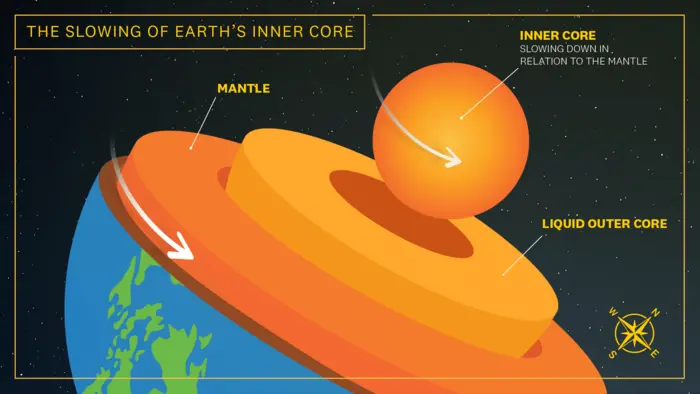Scientists at the University of Southern California (USC) have proven that the Earth’s inner core is slowing down in relation to the planet’s surface, according to a groundbreaking study published Wednesday in Nature. The findings provide unambiguous evidence that the inner core, once thought to be rotating faster than the Earth’s surface, began to decrease its speed around 2010.
John Vidale, Dean’s Professor of Earth Sciences at the USC Dornsife College of Letters, Arts and Sciences, was initially puzzled by the seismograms that hinted at this change. “When I first saw the seismograms that hinted at this change, I was stumped,” he said. “But when we found two dozen more observations signaling the same pattern, the result was inescapable. The inner core had slowed down for the first time in many decades.”
A Solid Iron-Nickel Sphere Surrounded by Liquid Mystery
The inner core, a solid iron-nickel sphere roughly the size of the moon, sits more than 3,000 miles beneath our feet, presenting a challenge to researchers who cannot directly visit or view it. Instead, scientists must rely on the seismic waves generated by earthquakes to create renderings of the inner core’s movement.
Vidale and Wei Wang of the Chinese Academy of Sciences took a fresh approach to studying the inner core by utilizing waveforms and repeating earthquakes, which are seismic events that occur at the same location and produce identical seismograms. The researchers compiled and analyzed seismic data recorded around the South Sandwich Islands from 121 repeating earthquakes that occurred between 1991 and 2023, as well as data from twin Soviet nuclear tests between 1971 and 1974 and repeated French and American nuclear tests from other studies of the inner core.
The Churning Dance of the Earth’s Core
According to Vidale, the inner core’s slowing speed is caused by the churning of the liquid iron outer core that surrounds it, which generates Earth’s magnetic field, as well as gravitational tugs from the dense regions of the overlying rocky mantle. The implications of this change in the inner core’s movement for Earth’s surface can only be speculated, with Vidale suggesting that the backtracking of the inner core may alter the length of a day by fractions of a second, almost lost in the noise of the churning oceans and atmosphere.
The USC scientists’ future research aims to chart the trajectory of the inner core in even greater detail to reveal exactly why it is shifting. “The dance of the inner core might be even more lively than we know so far,” Vidale said, hinting at the potential for further discoveries in this field of study.
The research, supported by the National Science Foundation (EAR-2041892) and the Institute of Geology and Geophysics of the Chinese Academy of Sciences (IGGCAS-201904 and IGGCAS-202204), involved collaboration with Ruoyan Wang of USC Dornsife, Wei Wang of the Chinese Academy of Sciences, Guanning Pang of Cornell University, and Keith Koper of the University of Utah.
As scientists continue to unravel the mysteries of the Earth’s inner workings, studies like this one shed new light on the complex dynamics that shape our planet and the challenges researchers face in understanding them.


